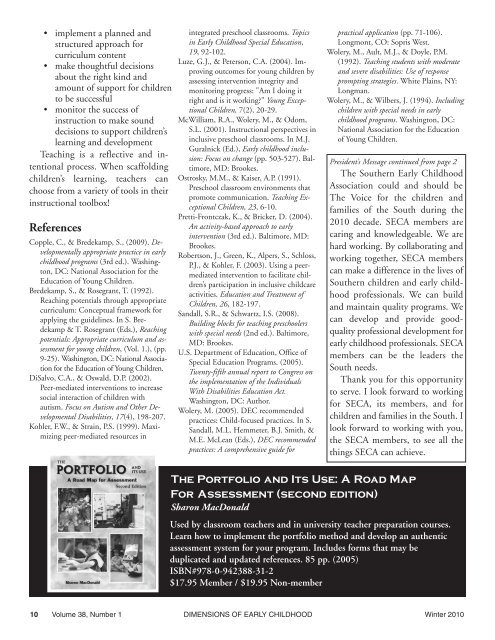90223 Dimensions Winter 10:Layout 1 - Southern Early Childhood ...
90223 Dimensions Winter 10:Layout 1 - Southern Early Childhood ...
90223 Dimensions Winter 10:Layout 1 - Southern Early Childhood ...
You also want an ePaper? Increase the reach of your titles
YUMPU automatically turns print PDFs into web optimized ePapers that Google loves.
• implement a planned and<br />
structured approach for<br />
curriculum content<br />
• make thoughtful decisions<br />
about the right kind and<br />
amount of support for children<br />
to be successful<br />
• monitor the success of<br />
instruction to make sound<br />
decisions to support children’s<br />
learning and development<br />
Teaching is a reflective and intentional<br />
process. When scaffolding<br />
children’s learning, teachers can<br />
choose from a variety of tools in their<br />
instructional toolbox!<br />
References<br />
Copple, C., & Bredekamp, S., (2009). Developmentally<br />
appropriate practice in early<br />
childhood programs (3rd ed.). Washington,<br />
DC: National Association for the<br />
Education of Young Children.<br />
Bredekamp, S., & Rosegrant, T. (1992).<br />
Reaching potentials through appropriate<br />
curriculum: Conceptual framework for<br />
applying the guidelines. In S. Bredekamp<br />
& T. Rosegrant (Eds.), Reaching<br />
potentials: Appropriate curriculum and assessment<br />
for young children, (Vol. 1.), (pp.<br />
9-25). Washington, DC: National Association<br />
for the Education of Young Children.<br />
DiSalvo, C.A., & Oswald, D.P. (2002).<br />
Peer-mediated interventions to increase<br />
social interaction of children with<br />
autism. Focus on Autism and Other Developmental<br />
Disabilities, 17(4), 198-207.<br />
Kohler, F.W., & Strain, P.S. (1999). Maximizing<br />
peer-mediated resources in<br />
integrated preschool classrooms. Topics<br />
in <strong>Early</strong> <strong>Childhood</strong> Special Education,<br />
19, 92-<strong>10</strong>2.<br />
Luze, G.J., & Peterson, C.A. (2004). Improving<br />
outcomes for young children by<br />
assessing intervention integrity and<br />
monitoring progress: "Am I doing it<br />
right and is it working?" Young Exceptional<br />
Children, 7(2), 20-29.<br />
McWilliam, R.A., Wolery, M., & Odom,<br />
S.L. (2001). Instructional perspectives in<br />
inclusive preschool classrooms. In M.J.<br />
Guralnick (Ed.), <strong>Early</strong> childhood inclusion:<br />
Focus on change (pp. 503-527). Baltimore,<br />
MD: Brookes.<br />
Ostrosky, M.M., & Kaiser, A.P. (1991).<br />
Preschool classroom environments that<br />
promote communication. Teaching Exceptional<br />
Children, 23, 6-<strong>10</strong>.<br />
Pretti-Frontczak, K., & Bricker, D. (2004).<br />
An activity-based approach to early<br />
intervention (3rd ed.). Baltimore, MD:<br />
Brookes.<br />
Robertson, J., Green, K., Alpers, S., Schloss,<br />
P.J., & Kohler, F. (2003). Using a peermediated<br />
intervention to facilitate children’s<br />
participation in inclusive childcare<br />
activities. Education and Treatment of<br />
Children, 26, 182-197.<br />
Sandall, S.R., & Schwartz, I.S. (2008).<br />
Building blocks for teaching preschoolers<br />
with special needs (2nd ed.). Baltimore,<br />
MD: Brookes.<br />
U.S. Department of Education, Office of<br />
Special Education Programs. (2005).<br />
Twenty-fifth annual report to Congress on<br />
the implementation of the Individuals<br />
With Disabilities Education Act.<br />
Washington, DC: Author.<br />
Wolery, M. (2005). DEC recommended<br />
practices: Child-focused practices. In S.<br />
Sandall, M.L. Hemmeter, B.J. Smith, &<br />
M.E. McLean (Eds.), DEC recommended<br />
practices: A comprehensive guide for<br />
practical application (pp. 71-<strong>10</strong>6).<br />
Longmont, CO: Sopris West.<br />
Wolery, M., Ault, M.J., & Doyle, P.M.<br />
(1992). Teaching students with moderate<br />
and severe disabilities: Use of response<br />
prompting strategies. White Plains, NY:<br />
Longman.<br />
Wolery, M., & Wilbers, J. (1994). Including<br />
children with special needs in early<br />
childhood programs. Washington, DC:<br />
National Association for the Education<br />
of Young Children.<br />
President’s Message continued from page 2<br />
The <strong>Southern</strong> <strong>Early</strong> <strong>Childhood</strong><br />
Association could and should be<br />
The Voice for the children and<br />
families of the South during the<br />
20<strong>10</strong> decade. SECA members are<br />
caring and knowledgeable. We are<br />
hard working. By collaborating and<br />
working together, SECA members<br />
can make a difference in the lives of<br />
<strong>Southern</strong> children and early childhood<br />
professionals. We can build<br />
and maintain quality programs. We<br />
can develop and provide goodquality<br />
professional development for<br />
early childhood professionals. SECA<br />
members can be the leaders the<br />
South needs.<br />
Thank you for this opportunity<br />
to serve. I look forward to working<br />
for SECA, its members, and for<br />
children and families in the South. I<br />
look forward to working with you,<br />
the SECA members, to see all the<br />
things SECA can achieve.<br />
The Portfolio and Its Use: A Road Map<br />
For Assessment (second edition)<br />
Sharon MacDonald<br />
Used by classroom teachers and in university teacher preparation courses.<br />
Learn how to implement the portfolio method and develop an authentic<br />
assessment system for your program. Includes forms that may be<br />
duplicated and updated references. 85 pp. (2005)<br />
ISBN#978-0-942388-31-2<br />
$17.95 Member / $19.95 Non-member<br />
<strong>10</strong> Volume 38, Number 1 DIMENSIONS OF EARLY CHILDHOOD <strong>Winter</strong> 20<strong>10</strong>
















